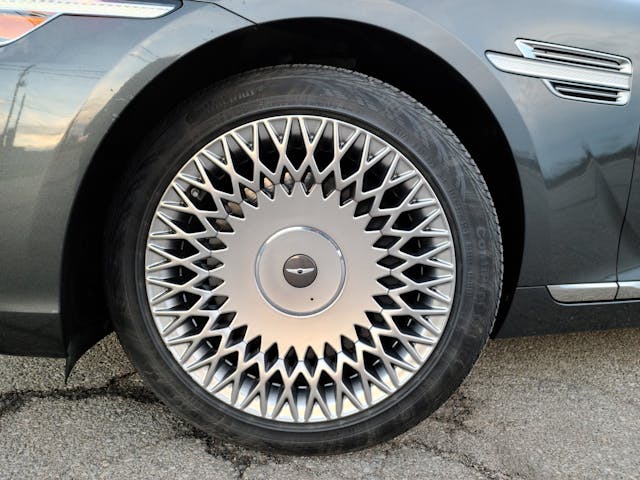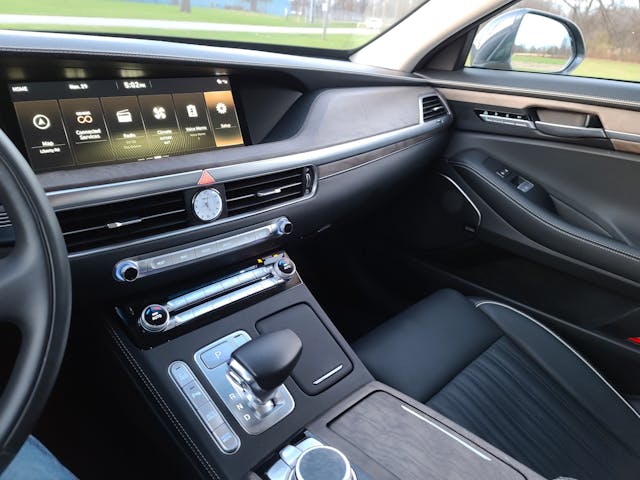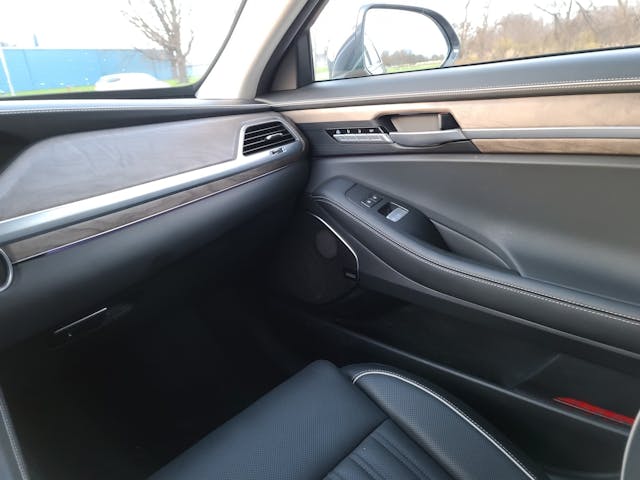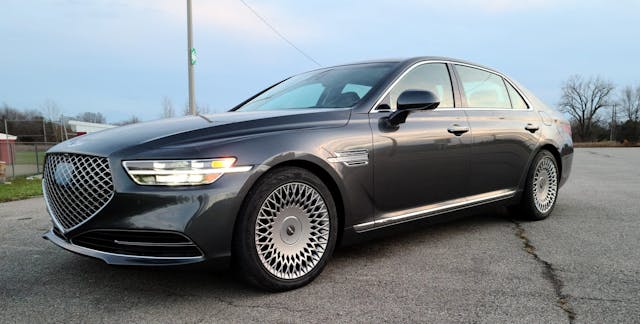Review: 2020 Hyundai Genesis G90 5.0 Ultimate RWD
True story: If you wanted a new Fender Stratocaster in 1985 or 1986, all of your choices were made in Japan. Three years before, the company had handed responsibility for virtually all of its production to a Japanese company called FujiGen Gakki—and in 1985, when CBS sold the Fender brand, its Fullerton, California factory went ahead and shut down even the custom shop line. It took nearly three years to restart American production, this time in Corona, California. This decision to “turn Japanese,” first gradually then all at once, meant that many would-be young musicians, including your humble author, started with a guitar made in the Far East. I didn’t own a proper USA Fender guitar until twenty-seven years later, when I bought an American Deluxe Stratocaster in white pearl.
Like the fine folks at Fender, the nice people at Cadillac and Lincoln have abandoned the production of proper domestic full-sized luxury cars, first gradually then all at once. The last truly all-new American land yachts from the two firms in 1977 and 1979, respectively. (Save your letters; I know the B-body shared some components with the 1973 intermediates.) Since then we’ve had front-drivers, Fox-bodies, reskins, “aeros,” “Whales,” and one rather astounding LT1-powered Brougham. The final efforts from Detroit, the Fusion-based Continental and undersized CT6, were the equivalent of the German Navy’s pocket battleships, trying to do more with less. Now they’re gone, too.
Which leaves the car you see above as the last real full-sized American luxury car. It just happens to be made in Korea.

This is the Genesis G90, successor to the Equus, which was the successor to … a couple of badge-engineered Mitsubishis not sold in this country. Rather remarkably, Hyundai has been building big RWD sedans for all of about eleven years. Perhaps that explains why the current G90, which is a major re-skin of a new-for-2017 model, doesn’t really look like anything in particular. The styling has a little bit of modern Bentley, a little bit of Silver Seraph, and a few miniature nods to the 2009 Equus hidden in the mix. Overall, it’s probably an acquired taste. I liked the back end of the 2017 better (it had W222-style vertical taillamps) but think the nose of the new one is an improvement, both in the sheer blunt-faced menace of it and the way it ties in with the rest of the Genesis line. In any event, the styling properly communicates the sheer size and heft of the car to onlookers. In most ways, this is a long-wheelbase take on the 5-Series-sized G80 sedan, but you’d never know it to look at it.

About the wheels there can be no discussion. They are brilliant, paying homage to vintage BBS designs and proper wire wheels all at once, with a little touch of Eldorado Touring Coupe and 1982 Town Car Signature deep-dish cross-lace thrown in. If you disagree, then you are not in the market for a car like this.

In South Korea, this is primarily a livery car for the VIP crowd, which perhaps explains why the first Equus was a little cramped up front. Not so with the G90, which offers more room for the driver than a Lexus LS500 while falling a bit short of the amphitheater accommodations of the current (and previous) S-Class Benz. It’s difficult not to describe the interior without detouring into hagiography. The seats are highly adjustable and all-day comfortable, offering instant heat and considerable cooling power on request. All of the materials are at least class-appropriate, and the leather is very good indeed. CT6 owners will be astonished, while Continental Black Label owners will at least be agreeable.

Hyundai’s infotainment system is easy to understand, with good solid shortcut buttons surrounding an expensive-feeling rotary controller. Both the instrument panel and center screen are visible in all conditions. Unlike the original iDrive 7 Series and my Lincoln MKT, the G90 doesn’t require you to flick through a couple of screens to turn on the heated seats or adjust the climate controls. There’s a nice recessed area below the main controls that accepts, and charges, a full-sized smartphone. I can even muster a kind word for the console shifter, which is noticeably better to use than the equivalent BMW or General Motors control. The big “P” button for Park is goofy-looking, but this is a car aimed at older drivers, and they’ll be glad of it.

There’s nothing in the G90’s cockpit to chastise its owner for choosing a $76,000 Korean car over the $106,000 German equivalent, which is nice. If there’s a gripe to be made, it’s the relatively short list of available interior colors and finishes, a consequence of the G90’s modest sales volume in our market.

The news is just as good in the back. Like the Continental and LS500, the G90 can be had with a comprehensive suite of rear controls, accessed through screens that replicate the center screen’s infotainment abilities up to and including a “projection” feature available from a USB-cable-connected device. If you happen to have an eleven-year-old son with a flair for mischief, you’ll want to take advantage of the lockout feature available from the front seat, lest you be forced to listen to the first thirty seconds of a song ten times in a row, slightly louder each time, while the interior temperature swings wildly.

For illustration purposes, I had my old car-sales companion Rodney try out the back seat. He’s about six foot two and 265 pounds; he pronounced the available room “good enough,” particularly once he figured out how to recline the rear seat a bit. There’s no powered lower bolster in the U.S.-market G90, but the recline feature is as addictive in this car as it is on a cross-country flight.

One minor quibble: the G90 has three-zone climate control. This will only bother you if you’re a former Phaeton owner and remember the outstanding four-zone feature of that car. One nice thing about the G90’s interior HVAC, however, is that the screens clearly display where the airflow is coming from. This doesn’t sound like a useful feature, but it is. Trust me.

On the move, the G90 reveals itself as a proper luxury car in all respects. Road noise and wind noise are vanishingly low, courtesy of double-pane glass and a rock-solid unibody structure. Ride quality is a true cut above the Continental and CT6, equaled only by big Benzes that are not vandalized at the factory with AMG low-profile wheel/tire combinations. It’s so good that you immediately take it for granted, being surprised only upon entering another vehicle and receiving what feels like deliberate punishment but it really just business as usual.
Steering is one-finger light, as God and Mr. Sloan intended it to be, tightening up only when cornering forces rise above half a g or the “active” drive mode is selected. The brake and accelerator suggest a firm touch but it’s not 1985 Jaguar levels, more like BMW 7 Series. The absurdly felicitous experience of, say, driving a 1980 Fleetwood d’Elegance in period is perfectly rebooted here for a modern audience. There’s not a lick of “sporting intent” to be had, and that’s kind of the point. If you want to carve corners, get a sports car. This is a sedan for grownups—and the club racers who imitate them during the week.
Which isn’t to say that the G90 won’t hustle. There are two powertrains: the five-liter, 420-horsepower V-8 you really want, and the 365-horse twin-turbo 3.3-liter V-6 that should be avoided at all costs, not because it’s bad but because it doesn’t suit the car’s nature. You also get a choice between RWD and AWD, which you can make based on how often it snows where you live. My 5.0 RWD tester felt like it would run a low thirteen-second quarter-mile, its cultured growl accompanied by a mild rise of the prow under full steam in best Town Car Cartier fashion. At the approximate cornering limit, the big Hyundai, er, Genesis, lightly punishes the front tires as you’d expect.
Two electronic features deserve separate consideration here. The first is the active cruise control, which is either best in class or close to it. Given a chance, it will even negotiate a relatively curvy back road. Don’t get in the habit of doing that, because intersections confuse the system. On the freeway, the system is almost beyond reproach, although the usual ACC caveat applies, namely: Sudden motions by a car 100 feet ahead of you can inadvertently cause you to make some real enemies in your own vicinity of traffic.
The second feature: When you signal to change lanes, the G90 will show you a camera’s-eye view of the blind spot. Honda used to do this on the passenger side, but the Genesis does it for both. It is more addictive than reclining the rear seat, only slightly less so than Dilaudid, and will likely cause you to have a lot of close calls in your other car. Unlike Honda’s system, however, the G90 doesn’t give you a nice superimposed line on the display to denote the back bumper for those real guerilla warfare traffic moves. Probably for the best. Brilliant feature regardless. Every car should have it.

Audio quality is outstanding, as expected, with strong bass and excellent stereo imaging. I’d still give the nod to the Revel Ultima system in the Continental; that, and the flawless front seats, are the Lincoln’s two major advantages over the G90. The CT6, of course, can beat the G90 around the Nürburgring. In fact, almost anything could probably beat the G90 around the Nürburgring.
The complete self-assurance and fitness for purpose displayed by the biggest Genesis, up to and including the absolute lack of concern regarding Nürburgring times or lateral g, is part of why this is such a charming car. We’ve long been told that sedans like this are for old people, and at the age of forty-nine perhaps your humble author has simply drifted into the target market—but there’s also the fact that many Hagerty members and automotive enthusiasts have single-purpose, dynamics-focused vehicles elsewhere in their garage. Specialization might be for insects, as Heinlein once said, but it’s also good for automobiles if you can afford to indulge in it.
Who would buy a G90? Not many people, if the sales numbers can be believed — but the people who do are probably very satisfied. In an ersatz world of trucks pretending to be coupes, crossovers pretending to be sports cars, and luxury sedans pretending to be NASA American Iron racers, the G90’s unabashed commitment to comfort is thoroughly refreshing. I’d like to believe that General Motors and Ford are slightly ashamed of the manner in which Hyundai has shown them up here, and that we will eventually once again see production of a proper domestic full-sized car, the way Fender brought production back home in 1987. Until that day comes, however, the only place to find a proper Brougham is at your local Hyundai dealer.
Genesis G90 5.0 Ultimate RWD
Price: $76,700 (as tested)
Highs: A nearly perfect evocation of the modern full-sized luxury sedan. Looks the part. Great warranty. No more expensive than a fully-loaded half-ton pickup.
Lows: Sold and serviced by Hyundai dealers. Zero street cred among the Patagonia-vest crowd. Hyundai’s refusal to offer a Landau top amounts to corporate cowardice of the worst form.
Summary: Neither a fake S-Class nor a front-driver posing as a full-sizer, the G90 is a pure delight.


